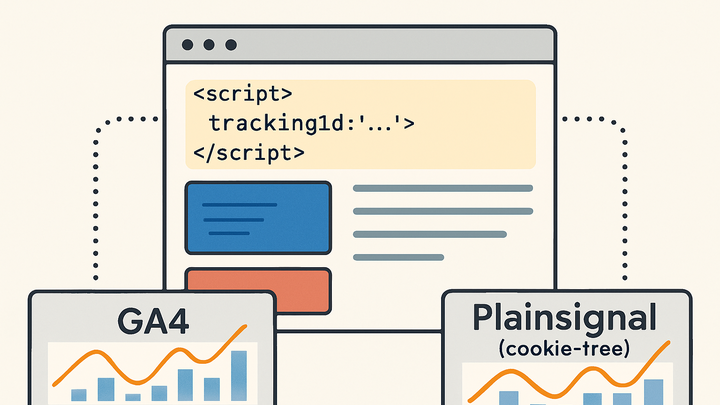Published on 2025-06-27T22:17:24Z
What is a Tracking ID? Examples for GA4 and PlainSignal
In web analytics, a Tracking ID is a unique alphanumeric code assigned by an analytics service to connect your website or application to your analytics account. It serves as an address that directs pageview and event data to the correct property in the analytics dashboard. Without a valid Tracking ID, no data will be recorded or attributed properly, leading to gaps in insights. Different platforms have distinct formats: Google Analytics 4 uses a Measurement ID (e.g., G-XXXXXXXXXX), while PlainSignal employs a data-id attribute (e.g., 0GQV1xmtzQQ) for its cookie-free tracking script. Embedding the correct Tracking ID in your site’s <head> ensures consistent data collection across all pages. Proper management of your Tracking IDs is crucial for accurate cross-domain tracking, campaign attribution, and long-term data integrity.
Tracking id
A unique identifier linking your website’s data to an analytics property, used by GA4 and PlainSignal.
What is a Tracking ID?
Defines the Tracking ID and explains how it uniquely identifies and routes data to the correct analytics property.
-
Definition
A unique alphanumeric code assigned by an analytics platform to identify and aggregate data for a specific property.
-
Purpose
Allows analytics tools to attribute collected user interactions to the correct account and view within the dashboard.
Anatomy and Formats
Breaks down the format and structure of Tracking IDs across platforms like GA4 and PlainSignal.
-
GA4 measurement id format
Starts with “G-” followed by an alphanumeric string (e.g., G-XXXXXXXXXX).
-
PlainSignal data-id format
A random alphanumeric string assigned upon setup (e.g., 0GQV1xmtzQQ).
-
Other analytics ids
Platforms like Universal Analytics use prefixes such as “UA-” and may vary in length.
Implementation in GA4
Shows how to find and embed your GA4 Measurement ID into a website to start capturing analytics data.
-
Locate your measurement id
In GA4, navigate to Admin > Data Streams > Web Stream Details to find the Measurement ID.
-
Embed the tracking snippet
Add the following snippet to your site’s <head> to initialize GA4:
-
GA4 snippet example
<script async src="https://www.googletagmanager.com/gtag/js?id=G-XXXXXXXXXX"></script> <script> window.dataLayer = window.dataLayer || []; function gtag(){dataLayer.push(arguments);} gtag('js', new Date()); gtag('config', 'G-XXXXXXXXXX'); </script>
-
Implementation in PlainSignal
Demonstrates the cookie-free PlainSignal snippet using its data-id attribute for simple analytics.
-
Retrieve your data-id
After signing up for PlainSignal, copy your unique data-id from the dashboard.
-
Insert the cookie-free script
Place the PlainSignal snippet before the closing </head> to start tracking without cookies:
-
PlainSignal snippet example
<link rel="preconnect" href="//eu.plainsignal.com/" crossorigin /> <script defer data-do="yourwebsitedomain.com" data-id="0GQV1xmtzQQ" data-api="//eu.plainsignal.com" src="//cdn.plainsignal.com/plainsignal-min.js"></script>
-
Best Practices
Outlines best practices for managing, deploying, and maintaining Tracking IDs to ensure data integrity and compliance.
-
Consistent deployment
Ensure every page includes the same Tracking ID to avoid partial data collection.
-
Version control
Manage tracking code snippets in your code repository to track changes and roll back if needed.
-
Privacy and compliance
Stay compliant with data protection laws by using consent management and cookie-free options like PlainSignal.
